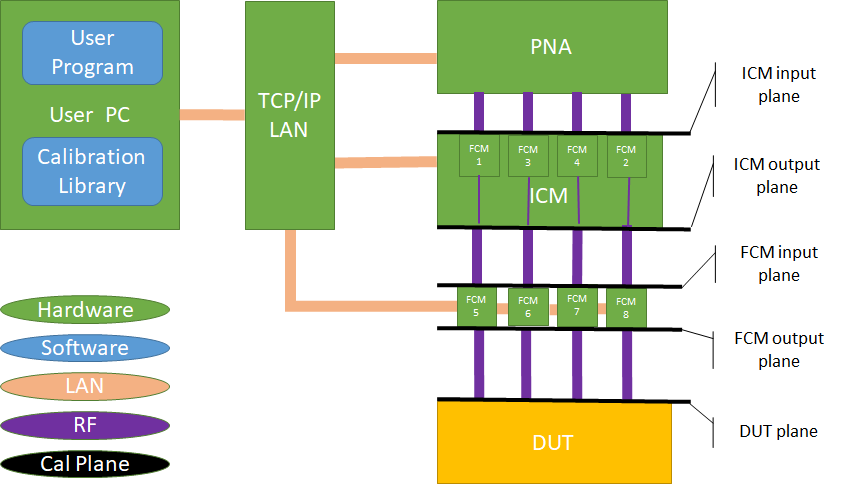Calibrations
Performing a calibration removes one or more of the systematic errors using an equation called an error model. Measurement of high quality standards (for example, a short, open, load, and thru) allows the analyzer to solve for the error terms in the error model. For more information on measurement errors see the Keysight Documentation.
One can choose from different calibration types, depending on the measurement you are making. With the exception of characterizations requiring operator interaction, the calibration is performed using a PNA and one or more ATE Systems calibration devices. The ATE Systems InCal library facilitates the use of these devices and automates the execution of the calibration measurement and updating the error model on the PNA.
Please refer to the diagram below as a reference to the explanations provided of the calibration categories.

The InCal library groups calibration measurements into 3 categories:
This group of calibrations calibrate the RF path starting at the PNA and ending at the input of a calibration device. In the diagram above that could be the segment from the PNA to the FCM input plane.
This group of operations use a provided characterization file to extend the calibrated plane outward from the reference plane toward the DUT. In the diagram above that would be from the FCM input plane to the DUT plane. The characterization file can either be provided by an external party, or measured internally using the characterizations requiring operator interactions.
This group of operations are used to characterize a path or coax cable using either Short Open Load Characterizations or AMB Split Characterizations which involve manual operator interaction. The result of these characterizations is a file that can be used to extend a reference plane.
Typically the initial segment from the PNA to the FCM input is more subject to drift due to electromechanical switching or long coaxial cables. This segment is usually calibrated using one of the automated PNA measured calibrations. The final segment from the FCM input plane to the DUT is normally less subject to drift and is therefore characterized at a less frequent interval. The characterization of the final segment up to the DUT reference plane is achieved using a short open load characterization which produces a deembed file that can be used in a calibration to extend a reference plane.
In less common circumstances when the FCM output plane and the DUT plane are the same the final segment is just the path through the calibration device. In this case an Extend with FCM File calibration can be used as ATE Systems' devices have that path already characterized and stored on the device's internal memory.
For calibrations of more than 1 port an "unknown thru" path must be measured. To facilitate the automation of connecting the unknown through path an Integrated Calibration Module (ICM) can be used that the InCal library is configured to control.